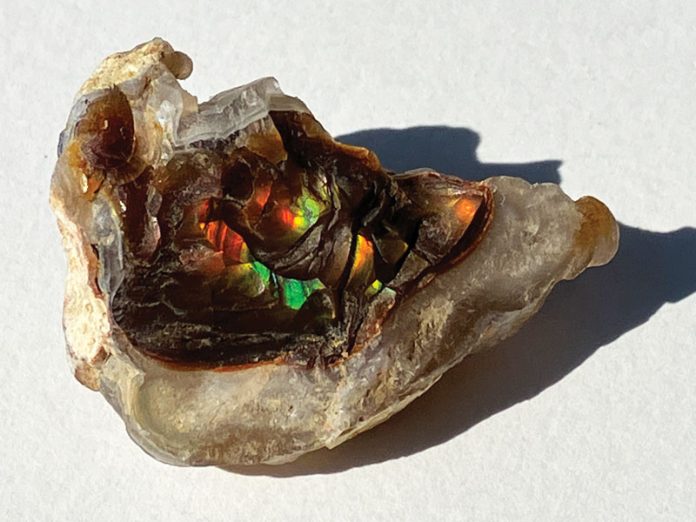
Fire agate may be one stone, but it is two minerals: chalcedony agate and iron oxide, usually in the form of goethite or limonite. Chalcedony was deposited little by little in bubbly botryoidal layers. Now and again, a hair-thin layer of iron oxide formed, only to be covered by more chalcedony, and those ultra-thin metallic layers give fire agate its fire thanks to the Schiller effect.
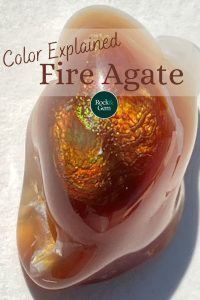
What is the Schiller Effect?
The Schiller effect occurs when light shines into a translucent mineral containing thin layers or platelets of metals. The light gets diffracted and sends out colorful shimmers.
Forged by Earth’s Fire
Fire agate started thanks to fire within the Earth. A group of volcanoes came alive between 36 and 24 million years ago. They spewed fire-hot lava. As it hardened, it cracked and formed crevices and pockets that became permeated with groundwater. That water remained very hot thanks to magma beneath the surface, and it was rich in minerals. These minerals settled in layers within the crevices and pockets. The result? Fire agate!
Found In Few Places on Earth
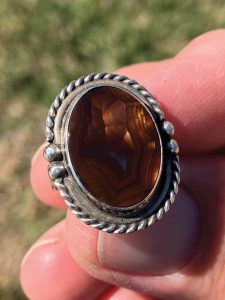
Adobe Stock / Arlenta Apostrophe
While agate, in general, is very common, fire agate is very rare. It is found in just a small corner of the world: the American Southwest (New Mexico, Arizona, California) and north-central Mexico. Sometimes you find it loose on the ground after it weathers free from volcanic rocks, but more often you need to dig, then pry it out with rock hammers, chisels, and pry bars. Even dynamite! Several mines have opened, and some allow amateur collectors to enjoy the strenuous labor of hard-rock mining for a fee.
A “New” Member of the Gemstone Family
While most major gemstones have been found and crafted for hundreds or thousands of years, fire agate is said to have been discovered only in 1939 in southeastern Arizona. It wasn’t until the mid-1940s that it started to be mined in any quantity and then introduced to the gemstone marketplace. At Mohs hardness of 6.5 to 7, it is durable and takes a fine shine. In other words, the perfect gemstone!
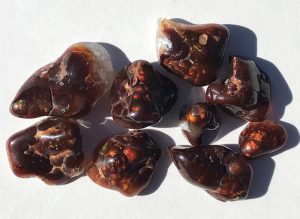
This Rare Gem Requires a Master Crafter
Crafting the perfect gem from fire agate takes the special care, attention, and utmost patience of master lapidary artists. They grind away the chalcedony to get close to the iron oxide layer. When ground to just the right level and polished, iridescent “fire” seems to leap from the stone with flashes of red, orange, yellow, green, bronze, and/or highly prized purple and blue. To get to the shimmering layer, you need to proceed slowly and carefully. Lapidary artists constantly evaluate as they go under bright light. Sunlight is best.
Common Pitfalls in Working With Fire Agate
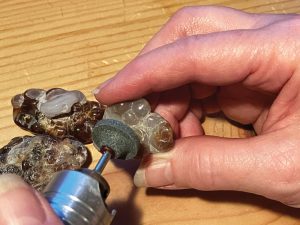
The best lapidary artists follow the contours of the bubbly Chalcedony when cutting into and grinding a fire agate. They employ a combination of rock saws, grinding wheels, handheld tools such as Dremels or Foredoms, and rock tumblers to get the most uniform shine that brings out the best shimmer. Along the way, they try to avoid several pitfalls:
• Not grinding away enough chalcedony dulls the fire.
• Grinding away too much and cutting into the iron oxide layer destroys the fire.
• Applying too much pressure when grinding overheats and cracks the stone.
• Grinding the stone flat rather than following the botryoidal contours results in some areas of great fire but other areas that are dull.
Fire Agate Lore & Legend
Because fire agate is a relatively new player in the gemstone world, there are no ancient legends associated with it. Arizonans once considered it their unofficial state mineral. (They have since designated wulfenite and turquoise as the official state mineral and gemstone.) New Age mystics consider fire agate a “protection stone” to deflect negative energies. Some New Agers call it “the spiritual flame of absolute perfection.” A spiritual flame it truly is!
This story about fire agate previously appeared in Rock & Gem magazine. Click here to subscribe. Story by Jim Brace-Thompson.












